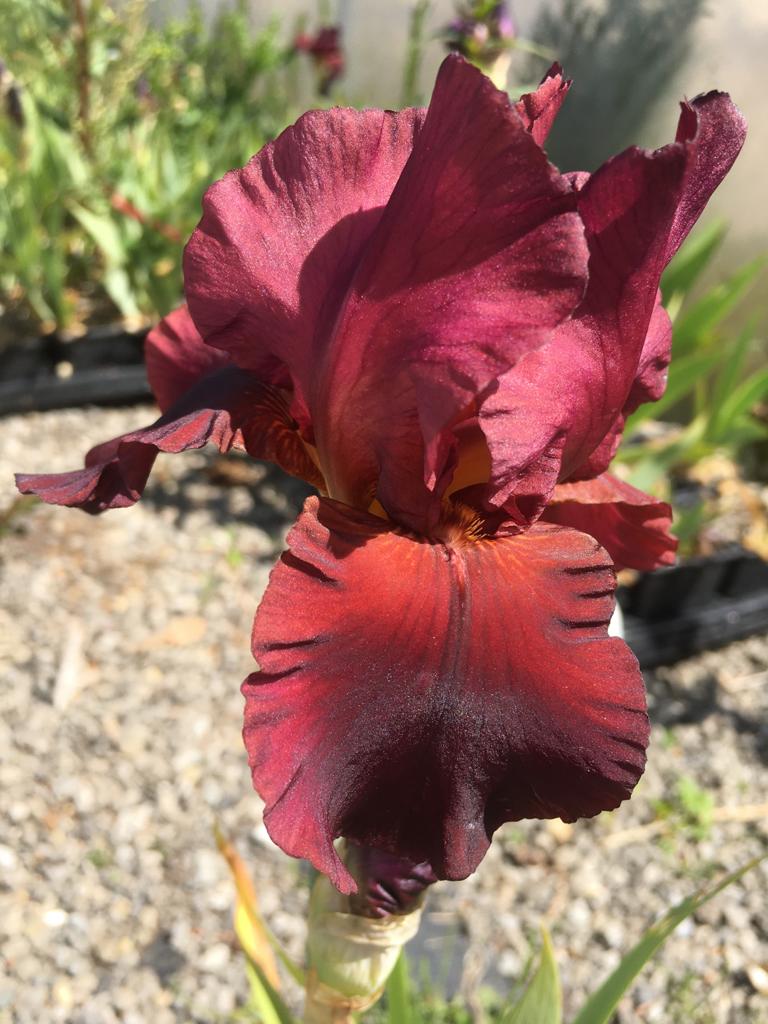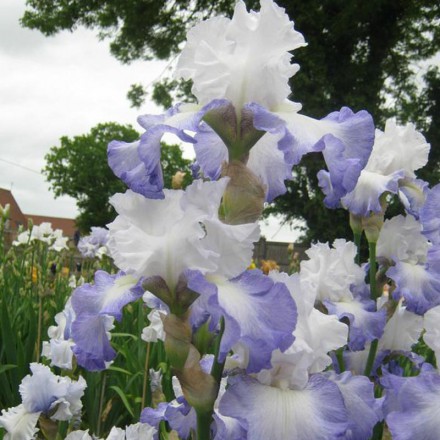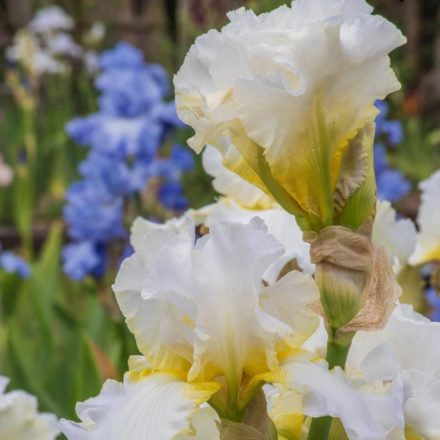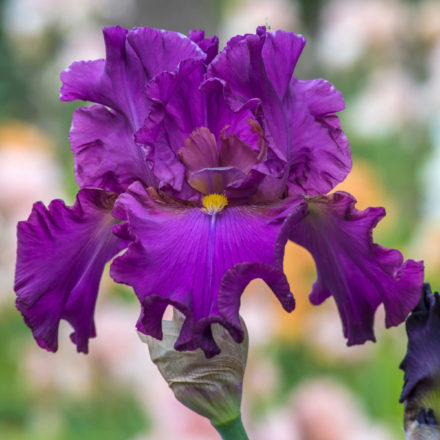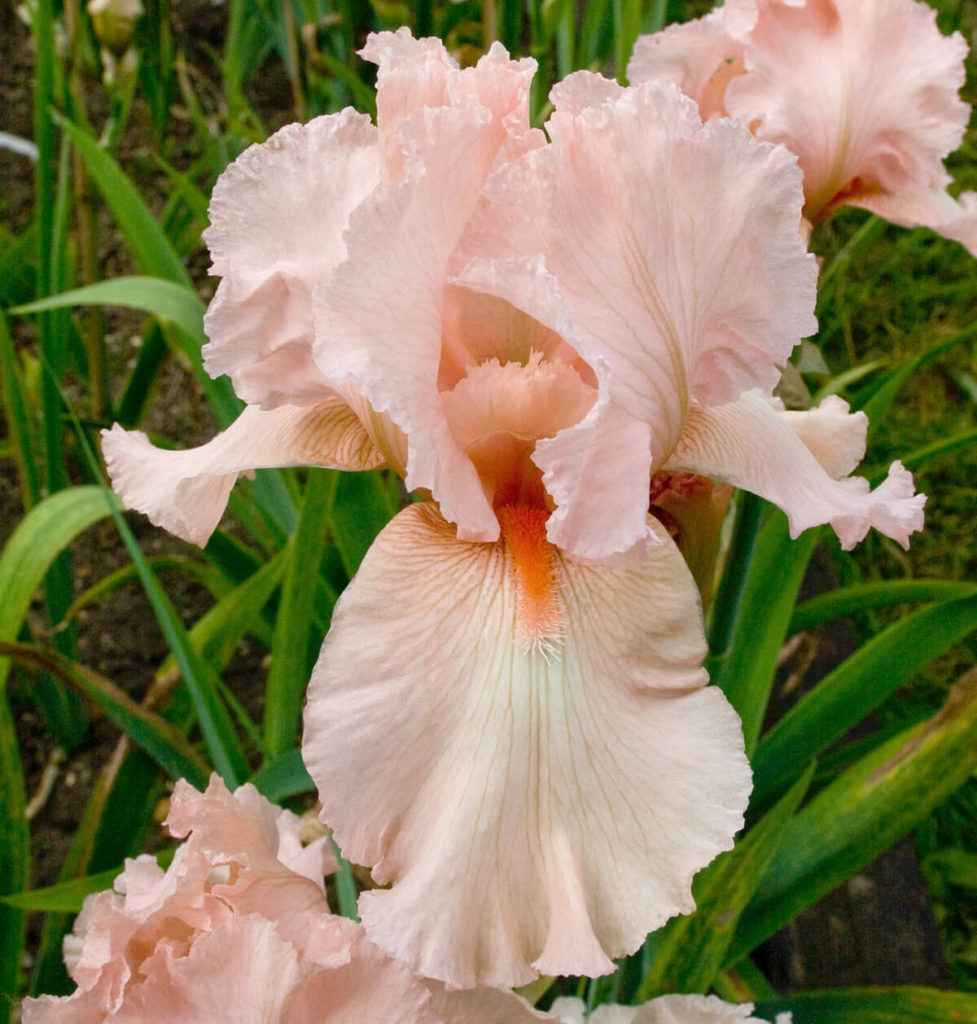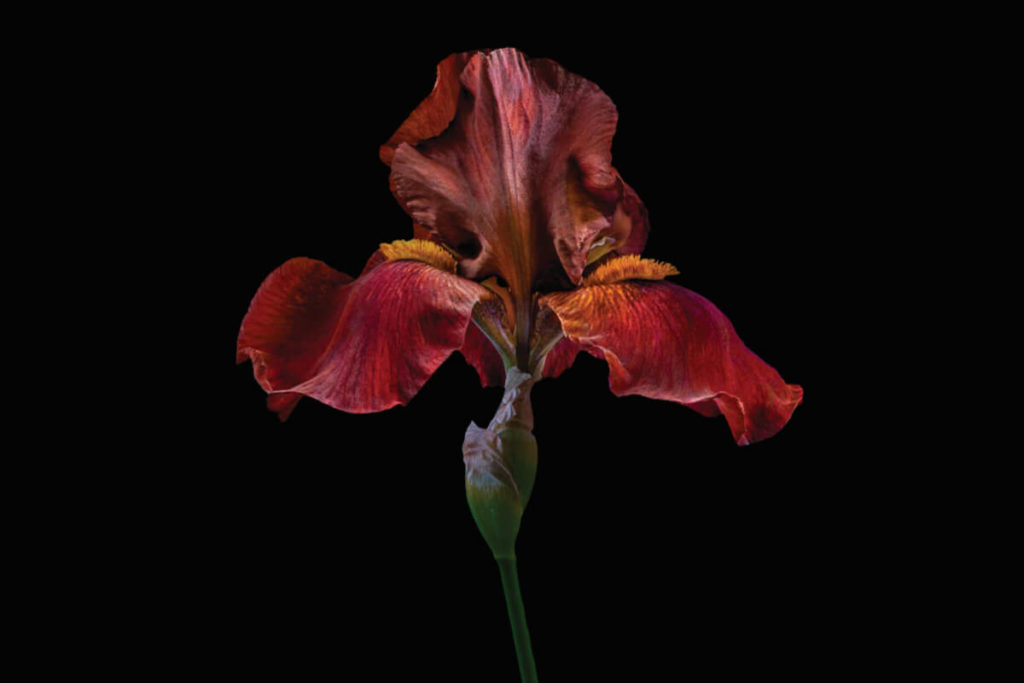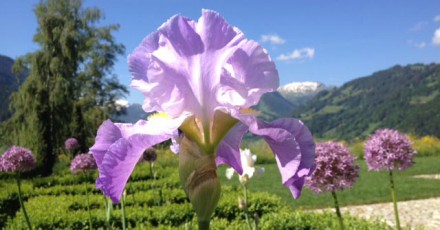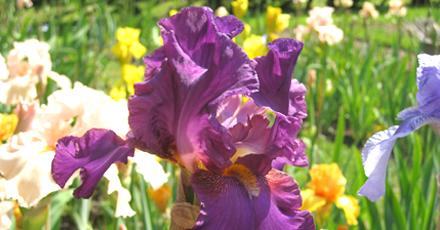This is a copy of the Autumn edition of our twice-yearly newsletter. If you would like to receive this please do feel free to subscribe.
We have all been through an extraordinary period in the last six months. It is now clear that we are going to have to get used to living with the Coronavirus which is here to stay for the foreseeable future.
Our gardens have become ever more important to us. They provide the means to maintain our morale, replenish our spirits and offer a future, a refuge beyond current events. They are also vital to us emotionally and provide the means to keep fit and active.
If ever there was a time to garden and find a way to invest in a future, surely it is now.
Thanks
We have had a great response to our irises and wanted to say thank you for supporting us as a small independent grower.
Time and again, customers have told us that they have made a point of singling out small nurseries, and this has been hugely appreciated during a period when all Plant Shows have been abandoned.
Thank you again for your support.
2020 Flowering Season
Reports from around the country about how our customers’ irises have performed this year have varied a lot. In some parts of southern England, there were late frosts when the plants were about to flower, and this damaged some of the flower spikes.
Many of us further north have enjoyed a great season, with incredible weather in April and May, extending into June.
Due to lockdown restrictions I spent this period in Cumbria and was unable to see my irises flowering in Norfolk and this put an end to further hybridising. Not ideal, but there is always next year.
Ice Pinnacle
This is a tremendous Iris with great style and structure and terrific branching ; a classic ‘Amoena’ (white standards and lavender blue falls). An unusual and dramatic colour combination, but soft and subtle, a plant of real contrast and distinction.
Darley Dale
A classy iris with great shape and structure – a plant with real impact. One of the last irises raised by my father, justly earning him his final Dykes Medal when he was over eighty. A highly versatile ‘White’ and a must for those who love clear clean cool colours.
Blaeberry Pie
A really striking new introduction with great form and structure. Magenta standards and falls, beard yellow/rust. This plant adds real stature to the border. The branching is amazing, really architectural in style. The name recalls childhood visits to the Lakeland Fells to gather Blaeberries for a memorable fruit pie.
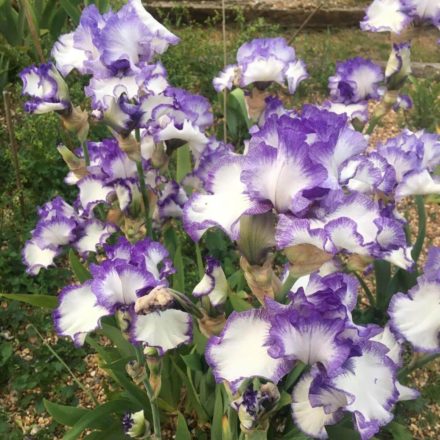
Monsal Dale
This is a highly distinctive iris and part of the National Collection. It’s one of three ‘plicata’s’ we have, along with ‘Hornpipe’ and ‘Dotterel’. We plan to release more irises from the Collection in time and will try to to add one or two every couple of years.
Website Changes
We have spent time this year updating the website in response to feedback from our customers. This has gone down well, with comments that the site is user friendly, easy to navigate, great visually etc.
Specifically, we have been trying to improve our search ranking through use of the right ‘keywords’. The feedback we receive from our customers whom we contact after placing orders, has been very valuable.
There are further changes planned later this year that will improve access from mobile phones. We see this as essential. By and large customers find the site easy to use and they like the clear images and plant descriptions.
Our focus remains to make sure that finding the site becomes as easy as possible and that our rankings are competitive with other iris suppliers.
Grouping Plants by Colour
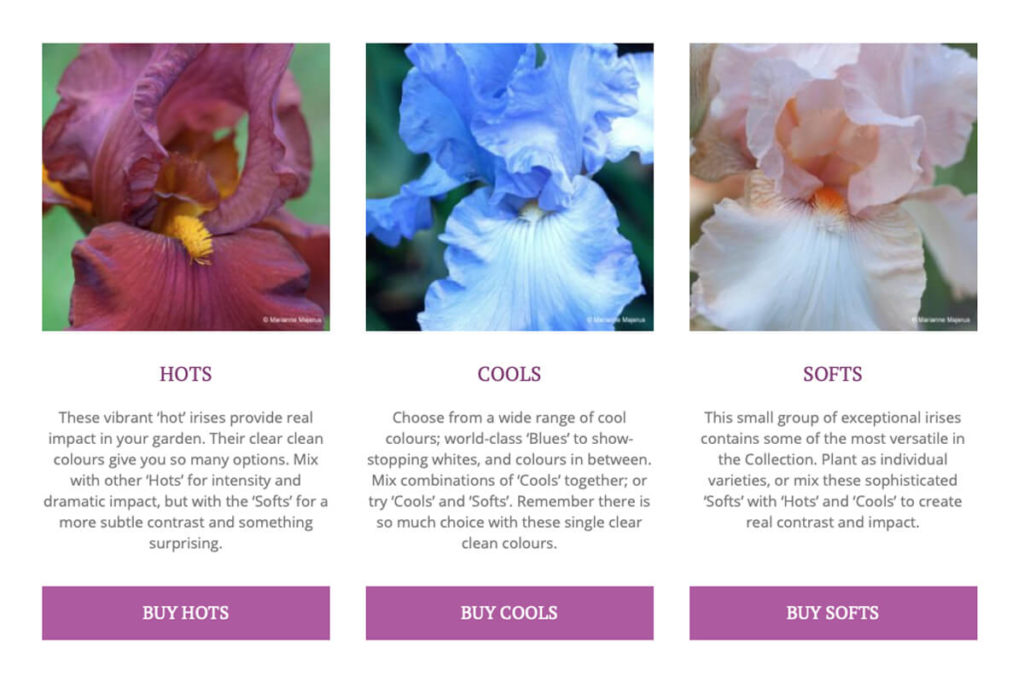
One of the great benefits of the ‘Dodsworth’ irises are that they are largely of a single colour, or shades of the same colour. This allows you to mix colours and experiment with different colour combinations.
Our customers seem to have really taken this on board and are already buying different combinations of irises; this is really encouraging.
I have just planted a large circular iris border for my daughter in the North of England that includes quadrants of ‘Hot’ and ‘Cool’ colours, with ‘Softs’ interspersed within each colour group.
It will take two years before it becomes fully established, but I will keep you posted on progress.
Extending the Flowering Season
By including irises with different ‘bloom periods’ in the mix, remember that you can extend the flowering period from the normal 3-4 weeks to at least 4-6 weeks.
If you are keen to make the most of the flowering season, make sure you have a representative selection of ‘Early’, ‘Mid’ and ‘Late’ blooming irises.
In this context I always recommend Sherwood Pink, a great iris in its own right, but one that flowers at least a week later than anything else in my garden.
Late Orders
We are still taking iris orders and the weather is still very mild. Now is your chance to place any late orders for 2020 as you plan your garden for 2021. During the last six months I have been sending out irises once per month.
The next delivery will go out later in October. The ground is still warm, and in some parts of the country we have had some rain, I appreciate that it is still very dry in the south and east of England.
We have reasonable stocks of most varieties. Why not experiment and try a new mix of colours, or just add some new varieties to your existing iris collection?

Our Gift Vouchers are increasingly popular. We deal regularly with recipients of vouchers and know this to be the case. With current Covid concerns they provide a safe and reliable way to send a highly individual present to gardening friends.
They are ideal Christmas presents, and work just as well for birthdays and anniversaries.
If you are stuck for a present this Christmas, this might be just what you are looking for. I deal a lot with recipients of vouchers during the year, and am always very happy to offer help/advice.
Irises are pretty ‘bombproof’ for novice gardeners and are a great way to get young people involved with gardening. Each voucher is sent out with a card which can include a message of your choice.
The image is of ‘Red Pike’ by RHS Multi Gold Medal Award Winning Photographer, Polina Plotnikova.
Companion Plants
One of my autumn projects this year is to research companion planting with bearded irises. I need to include a new section on the website.
We already use a number of different combinations, including Alliums, compact varieties of Lavender, and some of the less invasive grasses.
We all know the problem of keeping the rhizomes clear of encroaching plants to ensure good flowering the following year.
I would be very interested in your own experiences, successes and failures.
Please email Please switch on JavaScript to see our email address
2020 Events
You will appreciate that this is all very much up in the air at present.
Draw to Name an Iris
This will be made later this year.
Seasonal Gardening Tips
The planting section on our website is well visited and from the feedback we receive, much appreciated. It’s well worth reading the full guide, but here are a few pointers to help you this autumn:
Plant Hygiene
Allow your irises to keep growing until the end of October, mid-November if still warm, before cutting back into a fan shape of approx. 5”.
Remove all the old leaves from the base of the rhizome before you cut back the main leaves. When removing old flowering spikes, try not to cut them, but push the over with your thumb with a movement away from the rhizome until they ‘crack’…you will then have a clean break that will not allow any infection to develop.
Examine rhizomes and make sure they look strong and healthy, cut out any rotten/’spongey’ rhizomes. Watch for any signs that leaves are ‘floppy’ or pale yellow in colour – this is usually evidence of rot.
This needs to be dealt with immediately by cutting out the affected area and applying ‘Vitax’ or equivalent sulphur in powdered form.
If slugs are evident, use an organic product ‘Ferrimax’ approved by RHS or ‘Sluxx’, the product we use. Check websites for availability.
Splitting Rhizomes
Remember that you need to split the rhizomes to ensure regular flowering. There are two ways of doing this that are explained in detail on the website:
(i) Traditional - Split every 4/5 Years
(ii) Doddington Method – Remove old rhizomes to create space annually, leaving healthy stock in place.
You may also wish to watch this video on the Doddington method.
Depending on the number of irises you have, I would opt for the Doddington method which is simpler and ensures regular flowering each year. The traditional method may result in poor flowering in two out of the five years.
Feed
Remember to give your irises a good handful of bone meal this Autumn and work this into the ground around each plant. Do not use ‘Growmore’ or equivalent. Nitrogen will only encourage leaf growth and will contribute to iris rot.
Weeds
It’s a good time to check the iris beds and remove any perennial weeds before the onset of winter.
Please see our full guide for further information about planting and caring for your irises.
Enjoy your gardening and keep safe.
Simon Dodsworth
Owner
Email: Please switch on JavaScript to see our email address
Phone: +44(0)7789 670 299
